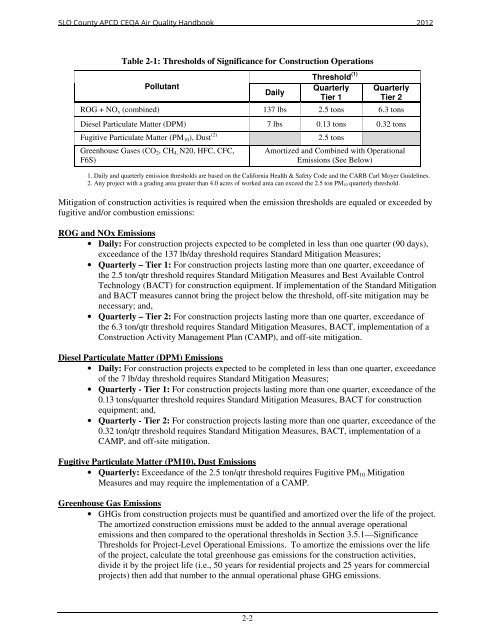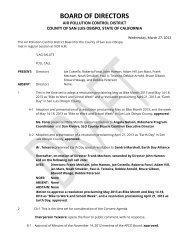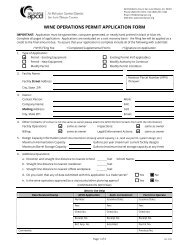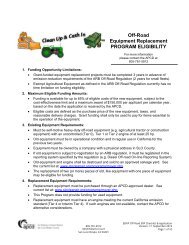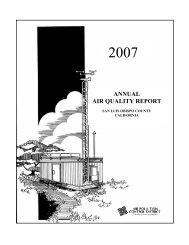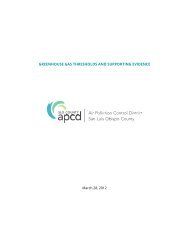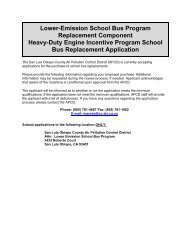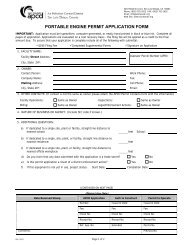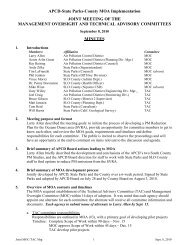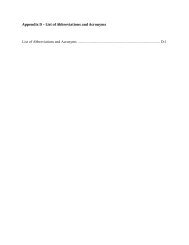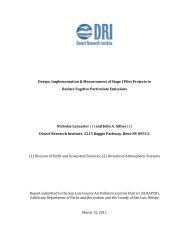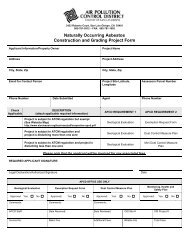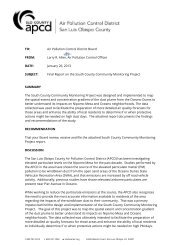CEQA Air Quality Handbook - Air Pollution Control District
CEQA Air Quality Handbook - Air Pollution Control District
CEQA Air Quality Handbook - Air Pollution Control District
You also want an ePaper? Increase the reach of your titles
YUMPU automatically turns print PDFs into web optimized ePapers that Google loves.
SLO County APCD <strong>CEQA</strong> <strong>Air</strong> <strong>Quality</strong> <strong>Handbook</strong> 2012<br />
Table 2-1: Thresholds of Significance for Construction Operations<br />
Pollutant<br />
Daily<br />
Threshold (1)<br />
Quarterly<br />
Tier 1<br />
Quarterly<br />
Tier 2<br />
ROG + NO x (combined) 137 lbs 2.5 tons 6.3 tons<br />
Diesel Particulate Matter (DPM) 7 lbs 0.13 tons 0.32 tons<br />
Fugitive Particulate Matter (PM 10 ), Dust (2)<br />
Greenhouse Gases (CO 2 , CH 4, N20, HFC, CFC,<br />
F6S)<br />
2.5 tons<br />
Amortized and Combined with Operational<br />
Emissions (See Below)<br />
1. Daily and quarterly emission thresholds are based on the California Health & Safety Code and the CARB Carl Moyer Guidelines.<br />
2. Any project with a grading area greater than 4.0 acres of worked area can exceed the 2.5 ton PM 10 quarterly threshold.<br />
Mitigation of construction activities is required when the emission thresholds are equaled or exceeded by<br />
fugitive and/or combustion emissions:<br />
ROG and NOx Emissions<br />
• Daily: For construction projects expected to be completed in less than one quarter (90 days),<br />
exceedance of the 137 lb/day threshold requires Standard Mitigation Measures;<br />
• Quarterly – Tier 1: For construction projects lasting more than one quarter, exceedance of<br />
the 2.5 ton/qtr threshold requires Standard Mitigation Measures and Best Available <strong>Control</strong><br />
Technology (BACT) for construction equipment. If implementation of the Standard Mitigation<br />
and BACT measures cannot bring the project below the threshold, off-site mitigation may be<br />
necessary; and,<br />
• Quarterly – Tier 2: For construction projects lasting more than one quarter, exceedance of<br />
the 6.3 ton/qtr threshold requires Standard Mitigation Measures, BACT, implementation of a<br />
Construction Activity Management Plan (CAMP), and off-site mitigation.<br />
Diesel Particulate Matter (DPM) Emissions<br />
• Daily: For construction projects expected to be completed in less than one quarter, exceedance<br />
of the 7 lb/day threshold requires Standard Mitigation Measures;<br />
• Quarterly - Tier 1: For construction projects lasting more than one quarter, exceedance of the<br />
0.13 tons/quarter threshold requires Standard Mitigation Measures, BACT for construction<br />
equipment; and,<br />
• Quarterly - Tier 2: For construction projects lasting more than one quarter, exceedance of the<br />
0.32 ton/qtr threshold requires Standard Mitigation Measures, BACT, implementation of a<br />
CAMP, and off-site mitigation.<br />
Fugitive Particulate Matter (PM10), Dust Emissions<br />
• Quarterly: Exceedance of the 2.5 ton/qtr threshold requires Fugitive PM 10 Mitigation<br />
Measures and may require the implementation of a CAMP.<br />
Greenhouse Gas Emissions<br />
• GHGs from construction projects must be quantified and amortized over the life of the project.<br />
The amortized construction emissions must be added to the annual average operational<br />
emissions and then compared to the operational thresholds in Section 3.5.1—Significance<br />
Thresholds for Project-Level Operational Emissions. To amortize the emissions over the life<br />
of the project, calculate the total greenhouse gas emissions for the construction activities,<br />
divide it by the project life (i.e., 50 years for residential projects and 25 years for commercial<br />
projects) then add that number to the annual operational phase GHG emissions.<br />
2-2


